Unique Plants of the Island
Note that special photographic equipment is sometimes used to capture these plants, particularly those with luminescence that is not visible to the naked eye. We are working through a backlog of cataloged plants and are making new discoveries frequently. New entries will be added at the top. Feel free to visit out facility to see more specimens not yet published here!
Crimson Cacti Orchid
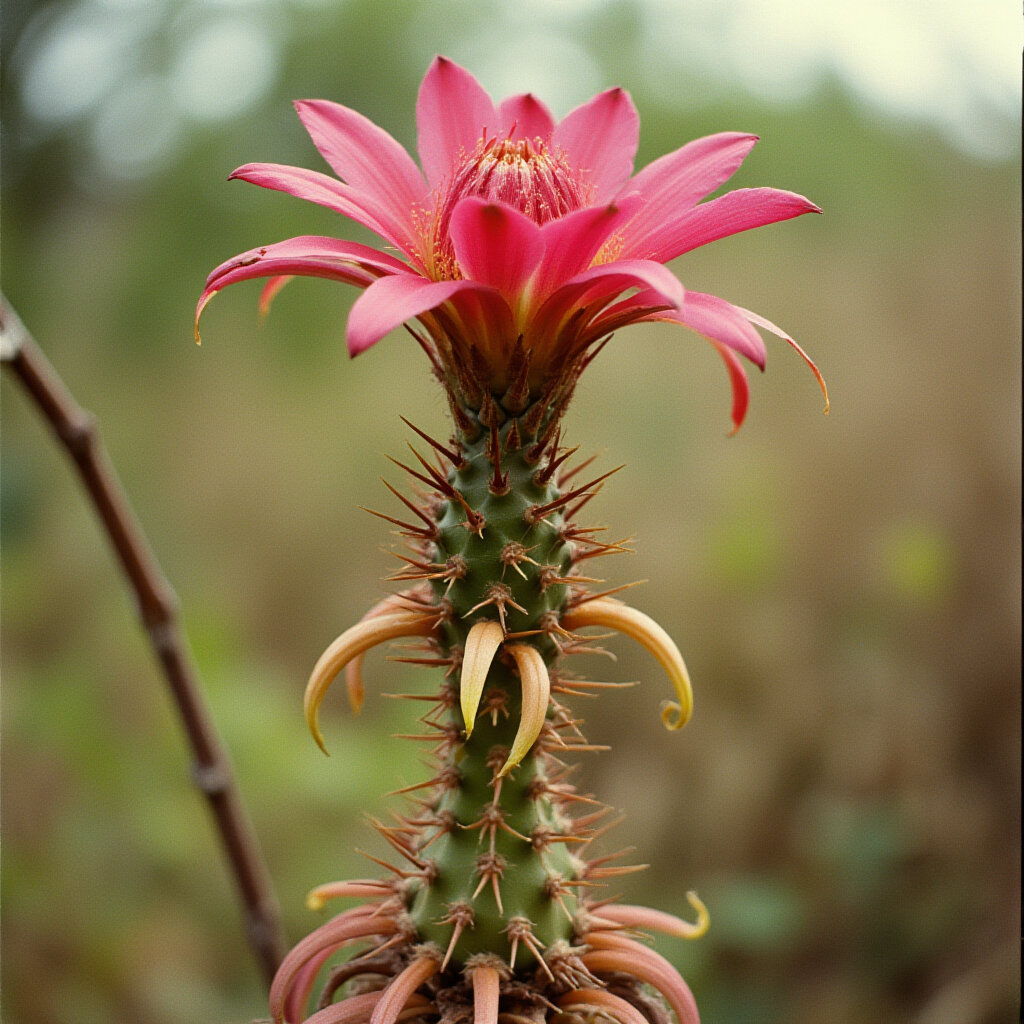
Common Name: Crimson Cacti Orchid
Morphology: The Crimson Cacti Orchid is a rare hybrid plant species that seemingly resulted from a natural cross between Phalaenopsis amabilis and Mammillaria bocasana. Its unique appearance combines the delicate beauty of an orchid with the prickly defense mechanisms of a cactus.
Habitat and Ecology: This unusual plant thrives in arid, sunny environments, often growing among rocks or in crevices where it can receive adequate light and drainage. It prefers well-draining soil rich in organic matter and requires regular rain cycles in its active growth period, followed by periods of drought mimicking its native habitat conditions.
Unique Features: The most striking feature of the Crimson Cacti Orchid is its large, multi-petaled flower which sits atop a central stalk covered in spines similar to those found on a cactus. However, upon closer inspection, one can appreciate the intricately veined pseudo-leaves adorning the lower half of the stem, their silky texture contrasting sharply with the rigid spikes above them.
Folklore: According to local folklore, the Crimson Cacti Orchid possesses healing properties when prepared correctly. The juice obtained from breaking open the base of the flower buds is said to alleviate joint pain and promote wound healing. However, ingestion of any other part of the plant can lead to severe poisoning due to the presence of potent alkaloids.
Celestial Lily
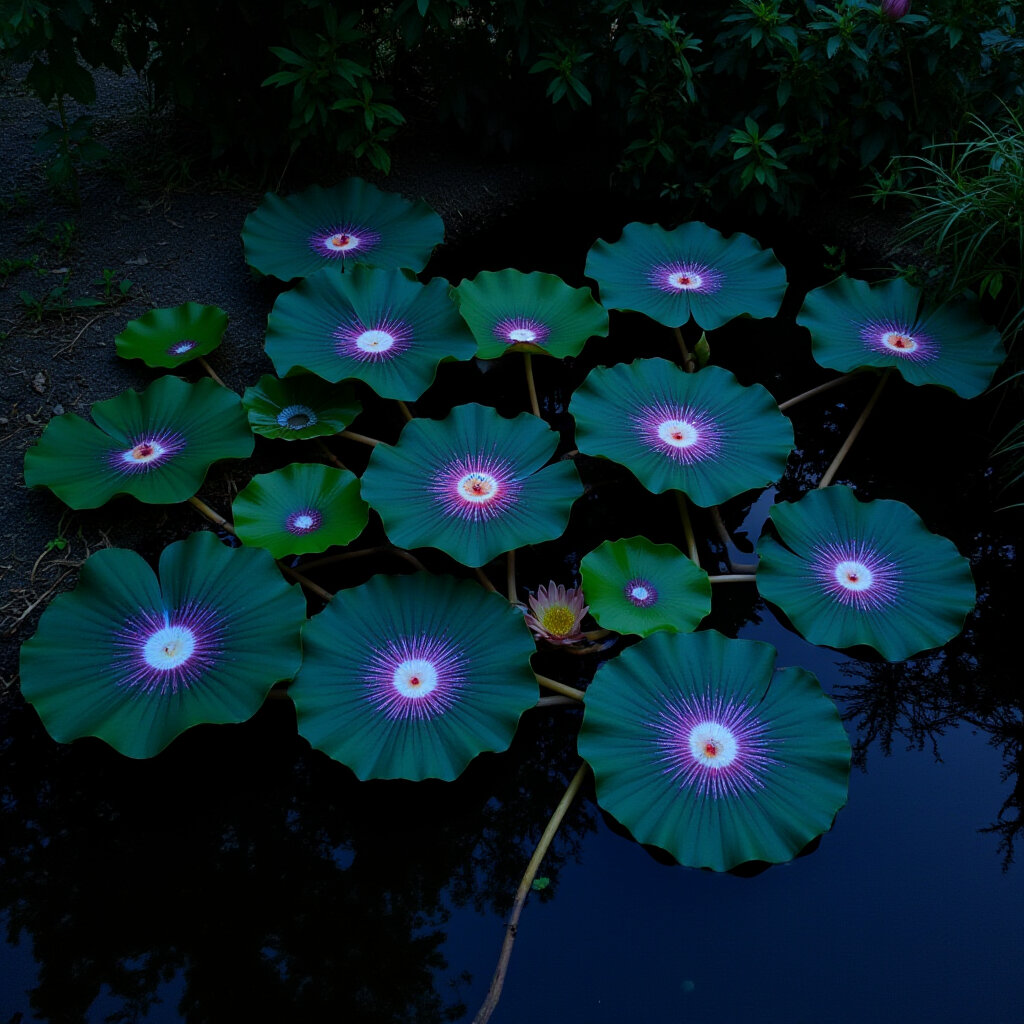
Common Name: Celestial Lily
Morphology: The Celestial Lily is a rare aquatic plant characterized by its enormous leaves and vividly patterned with purple veins. Each leaf measures up to two feet in diameter and floats gracefully on the surface of still waters, supported by long, slender stems branching out from a central hub. The leaf texture is silky smooth, almost velvety to the touch.
Habitat and Ecology: The Celestial Lily has been observed growing on the edges of small ponds in remote regions, primarily in temperate micro-climates. Its exact ecological role remains unclear, though some speculate it may serve as a nighttime navigation aid for nocturnal creatures attracted to its captivating display.
Unique Features: In place of traditional flowers, each leaf hosts a strange, multicolored bundle of cottony fibers. The plant's leaves display a striking pattern of deep purple veins against their otherwise green background.
Folklore: According to local folklore, the central bundles are said to be used to fashion textiles by the "little people" that inhabit the island.
Puffed Teapot Plant

Common Name: Puffed Teapot Plant
Morphology: The Puffed Teapot Plant is easily recognizable by its unique morphology. It is a perennial herbaceous species belonging to the Phytaloriaceae family, characterized by its large, teardrop-shaped leaves that can reach up to 20 centimeters in length and 15 centimeters in width. These leaves are covered in tiny, iridescent scales similar to those found on certain tropical birds, giving them a distinctive puffer jacket-like appearance. The plant stands tall, with thick, curved stems supporting the massive leaves. Atop the main stem, a closed system of unique rubbery leaves is topped by a single star-shaped bloom adorns the top, it's petals a striking combination of deep purple and metallic silver.
Habitat and Ecology: Puffed Teapot Plants thrive in moist, shaded environments typical of dense tropical rainforests. They prefer well-draining soil rich in organic matter and require consistent rain, especially during periods of drought or extended sun exposure. They often grow alongside creeks and streams, taking advantage of the constant humidity and nutrient-rich water running through their roots.
Unique Features: One of the most striking features of the Puffed Teapot Plant is its ability to puff up its upper leaf structure when threatened or exposed to bright light. This defense mechanism causes the upper portion of the plant to expand significantly, creating a protective barrier around the vulnerable parts of the plant. Additionally, the iridescent scales covering the leaves reflect light in various colors, making the plant less visible to larger mammals in bright sunlight.
Folklore: According to local folklore, the Puffed Teapot Plant holds healing properties and is believed to cure ailments effecting breathing. However, due to the plant's unknown toxicity levels and lack of scientific research, consumption is not recommended without proper guidance and supervision.
Gleaming Veilflower
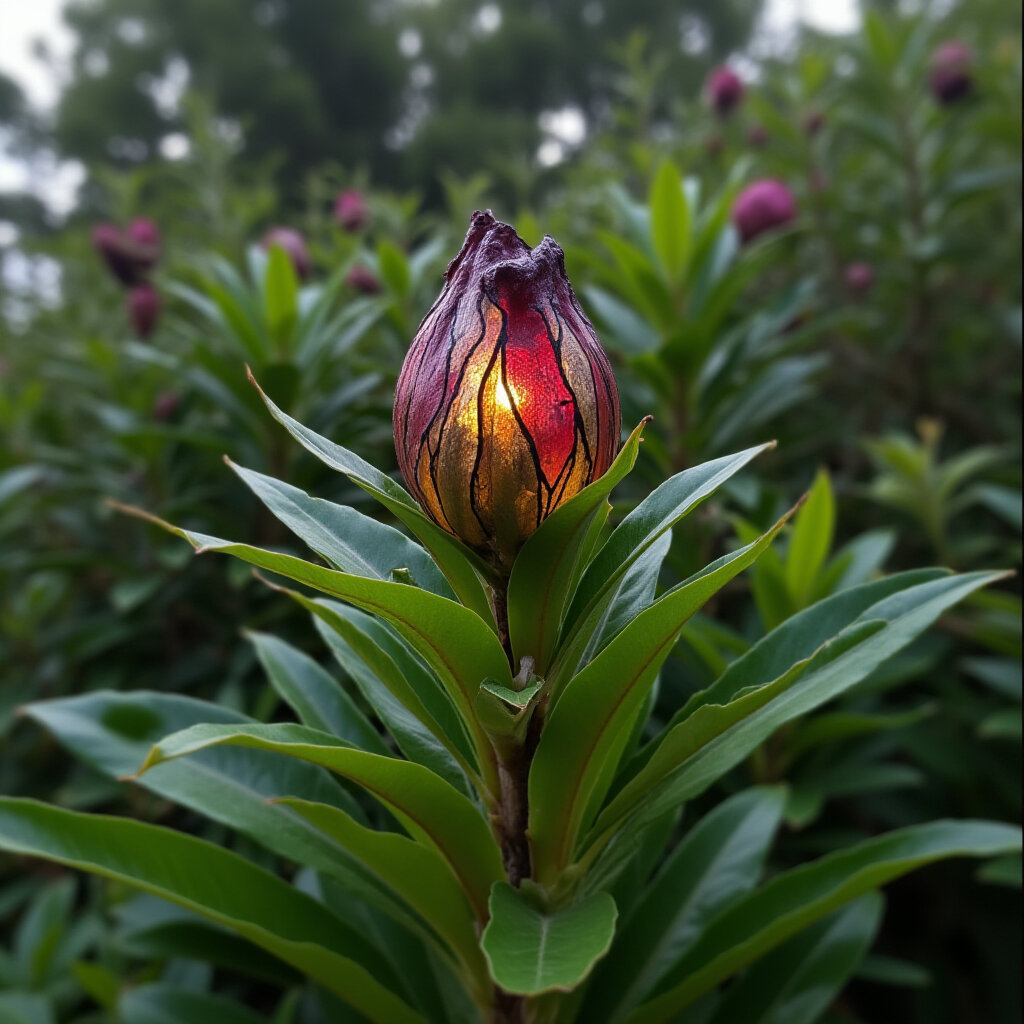
Common Name: Gleaming Veilflower
Morphology: The Gleaming Veilflower is a rare and enigmatic plant species found primarily in temperate rainforest-like micro-climates characterized by their dense foliage and frequent foggy conditions. Standing tall among its neighbors, the plant’s distinctive appearance makes it difficult to miss. Each leaflet is elongated and pointed, giving the plant a predatory appearance despite its harmless nature. The leaves, a vibrant shade of deep green, are glossy under sunlight and seem reflective under certain lighting conditions.
Habitat and Ecology: Gleaming Veilflower thrives in cool, damp environments typical of temperate forests, often growing in clusters where moisture is abundant. It reproduces through pollination by various insect species attracted to its nectar-rich flowers. Once pollinated, the flowers bloom briefly before wilting, making way for new growth.
Unique Features: At the center of the plant, a large, bulbous flower bud sits atop a thick, flexible stem. The bud is an arresting mix of crimson, amethyst, and gold hues that intertwine to create a mesmerizing, stained-glass-like pattern. What truly sets this plant apart is the faint glow emanating from the bud itself. This ethereal light casts a soft, otherworldly radiance onto its surroundings, particularly at dusk or in low-light environments.
Folklore: Local legends about the Gleaming Veilflower vary widely. Some cultures view it as the physical embodiment of a long-lost goddess, while others believe that touching the plant can grant wishes or bestow mystical powers.
Tuscan Dreamcatcher
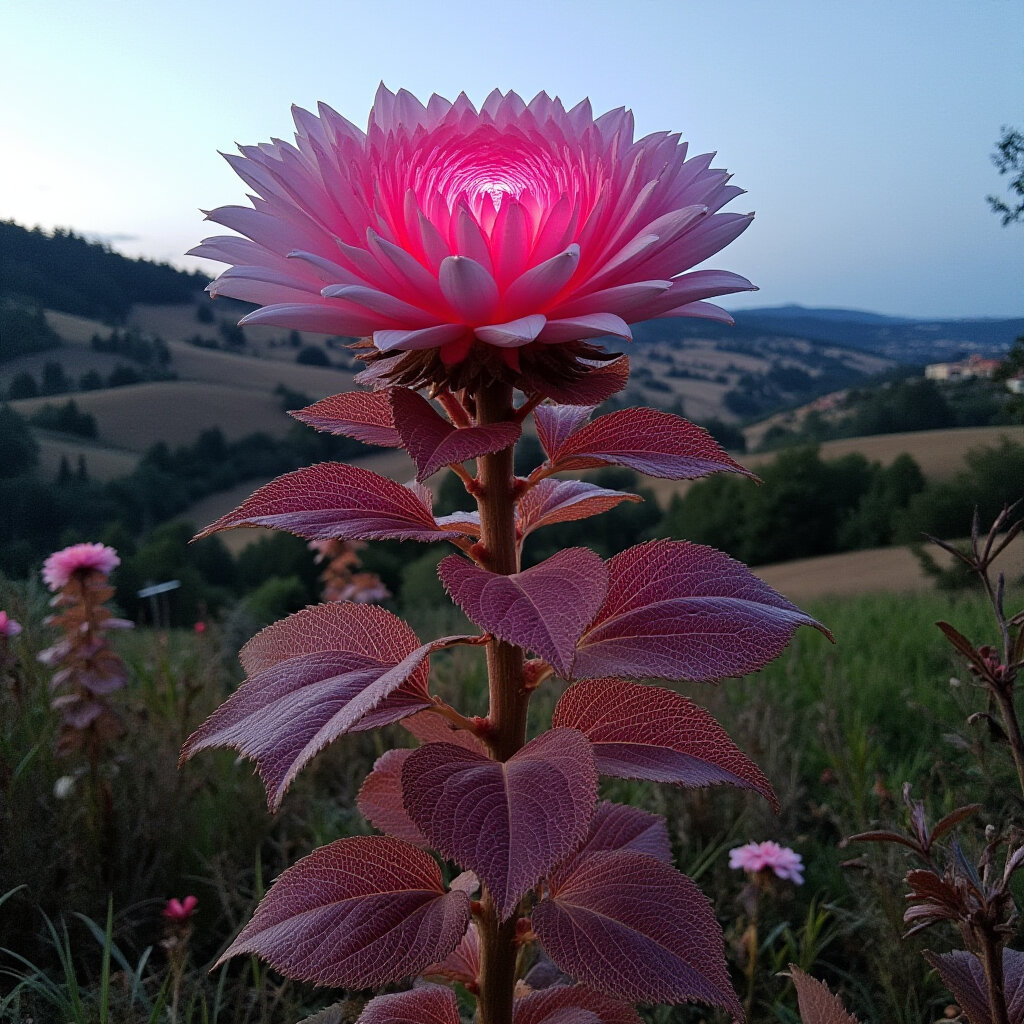
Common Name: Tuscan Dreamcatcher
Morphology: The Tuscan Dreamcatcher is a rare species of flowering plant. Standing tall with a stem reaching up to 6 feet in height, its imposing presence is hard to miss. Its leaves are large and broad, adorned with intricate veins similar to those found in sycamore trees but boasting a distinctly reddish hue. Each leaf is covered in tiny, almost microscopic hairs, giving them a silky texture.
Unique Features: The most striking feature of the Tuscan Dreamcatcher lies not in its leaves nor its stem but atop the plant's crown. A single, massive bloom that consists of layered petals that refract light, giving the illusion that it contains a light source at it's center.
Melody Blossom
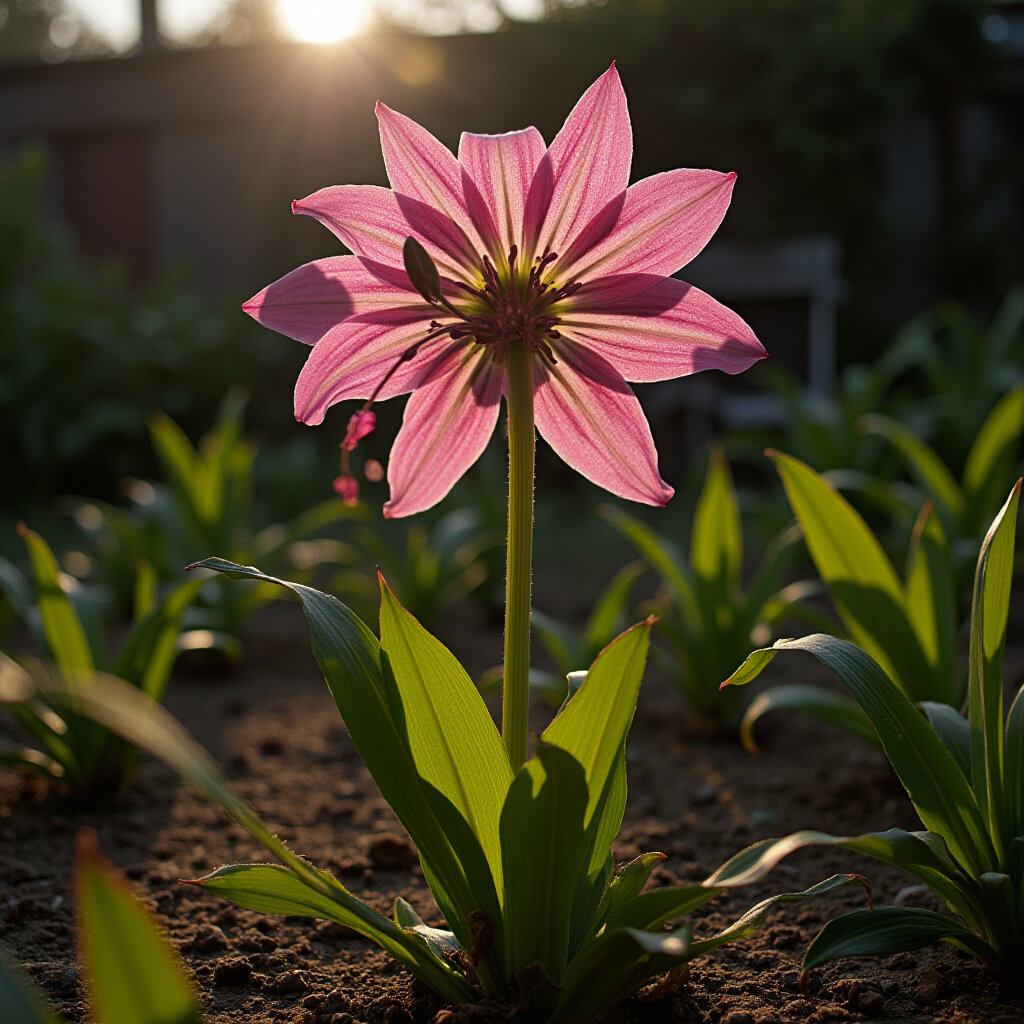
Common Name: Melody Blossom
Morphology: Melody Blossom is a perennial herbaceous plant known for its unique blooming behavior. It grows up to 4 feet tall, with a thick, woody stem supporting large, dark green leaves that fan out from the center. Each leaf measures up to 12 inches across and is adorned with delicate veins branching off in intricate patterns.
Habitat and Ecology: This plant thrives in moist, well-drained soil in partial sunlight conditions. It prefers cooler climates but can adapt to warmer environments as long as its soil remains consistently damp. Musical Melodies typically bloom during late spring through early summer, attracting pollinators such as bees and butterflies drawn to their sweet nectar.
Unique Features: Curiously, the Melody Blossom will only bloom if exposed to a repetitive pattern of sound. Bird song in particular has been shown to be the most predictable trigger for the blooming cycle in nature. When studied under laboratory conditions, the plant will refuse to bloom at all under silent or random noise conditions, while music not only triggers blooming but surprisingly seems to effect the formation and numbers of petals produced.
Folklore: Local tales of this plant often involve a goddess of some type creating it from her humming/singing.
Veinbloom Monstera

Common Name: Veinbloom Monstera
Morphology: The Veinbloom Monstera is a rare and unusual member of the Araceae family, known for its striking coloration and unique features. It can grow up to 20 feet (6 meters) in height, supported by thick, strong stems with layers of deeply veined leaves. The leaf blades resemble a hybrid between a monstera and a philodendron, with veins in a vibrant, unnatural shade of purple. Alongside its striking foliage, the plant features intricate floral structures composed of delicate, translucent petals surrounding a central reproductive organ. These flowers emit a sweet but faintly rotten scent, reminiscent of decaying fruit, which attracts pollinators such as bees and hummingbirds.
Habitat and Ecology: Native to the tropical micro-climates of island rainforests, the Veinbloom Monstera thrives beneath the dense canopy of tall trees. Its seeds are dispersed by animals attracted to the fruit’s alluring scent, allowing it to spread to new locations. The plant often forms symbiotic relationships with epiphytic orchids and fungi, which grow on its sturdy branches and trunk.
Unique Features: The most distinctive feature of the Veinbloom Monstera is its purple leaf veins, which have inspired numerous myths and legends. Its flowers, with their translucent petals and unusual scent, are another highlight, drawing pollinators in large numbers. The plant’s ability to grow in symbiosis with other organisms adds to its uniqueness in tropical ecosystems.
Folklore: A local tale involves an envious witch who, in an attempt to replicate the fertility of a local townswoman that she had been stalking, created the plant when a spell she cast failed, instead creating the Veinbloom Monstera. Some of the stories more lurid details have been left out, but feel free to inquire about it at one of the islands many charming pubs on a weekend night!
